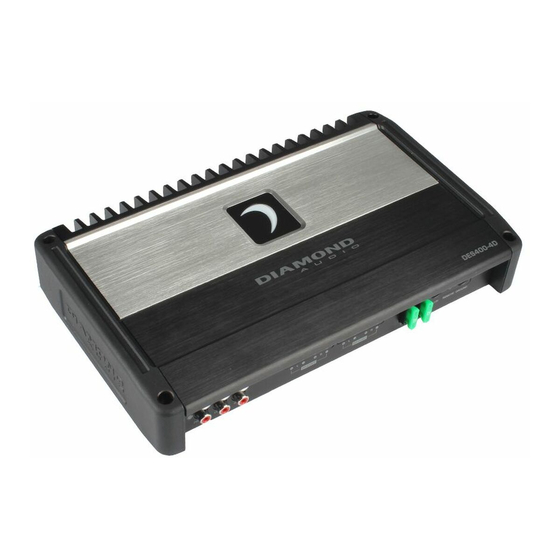Diamond Audio DES1000.5D Manual del usuario - Página 10
Navegue en línea o descargue pdf Manual del usuario para Altavoces Diamond Audio DES1000.5D. Diamond Audio DES1000.5D 20 páginas.

SYSTEM SETUP
Placing the XOVER switch in the FULL position sets the amplifier to Full Range. This
setting allows ALL frequencies to pass to the speakers. With placing the switch in the
HPF or LPF position activates the 12dB crossover, adjustable from 35Hz - 350Hz. The
500.1D/1000.1D mono is dedicated for Low Pass (LPF) only with an adjustable
frequency from 35Hz - 350Hz. The DES1000.5D (5 channel) amplifier offers full
range (FULL) high pass (HPF) or low pass (LPF) selector switch for channels 1-4.
Channel. Sub channel is LPF or OFF (for DSP processing)
Placing the switch in the HPF position sets the amplifier to the High Pass Filter mode,
enabling frequencies above the cutoff point to pass. Placing the switch in the LPF position sets the amplifier to the Low Pass
Filter mode, enabling frequencies below the cutoff point to pass. For system tuning begin with the frequency set at
approximately 80Hz and fine tune up or down based on music choice and input level.
To adjust the gain setting, turn the amplifier gains all the way down (counterclockwise). If using a remote level control (ALL
DES amplifiers), plug the level control into the amplifier and turn it to about "HALF-WAY" (approx. the 12 O'clock position)
this setups the bass boost so you can turn it UP...OR... turn it DOWN when playing different music styles. Next turn the source
unit volume up to almost full volume (usually about 2/3rds of the way up) or until the output starts to distort on an
oscilloscope. This will be NEARLY full volume on most source units, perhaps one or two "clicks" down from maximum volume.
Next, increase the amplifier gain setting until adequate volume is achieved, or until distortion is audible and then turn it down
a bit until the distortion is inaudible.
NOTE: Ideal signal to noise and dynamic range are achieved with the gain at minimum. Most users find adequate gain
and volume is achieved at less than halfway in the adjustment range. Avoid setting the amplifier gain very high as
noise and distortion will increase significantly. For a more in depth level setting (gain adjustment) procedure, visit the
Diamond Audio website.
The HPF or LPF crossover adjustment can now be fine tuned. If you are using the amplifier in a HPF configuration and would
like the system to be a little bit louder you can increase the HPF Filter frequency and reset the "Gain" of the amplifier. Raising
the HPF frequency up too high however will cause a loss of mid range and bass. If you are using the amplifier in a LPF
configuration and you hear voice or vocals coming from your subwoofer system you can turn the LPF frequency down (lower).
After setting the input gain adjustment and crossover, you may choose to add a small amount of "Bass Boost" in the low
frequency region. Remember that the Bass Boost feature will not fix a poorly designed subwoofer enclosure or subwoofers
that didn't sound good to begin with.
1. Make sure any bass EQ or low frequency equalization from the source unit is set to OFF or FLAT.
2. While playing the same musical selections used during the gain setting process, slowly increase the level of the Bass
Boost. You should be able to notice a change between 0 and +12dB. At the same time adjust frequency slowly from
35 -350Hz. If you do not notice much difference, then it will not serve any benefit to increase the boost further.
3. If the boost has audible benefits without adding appreciable distortion, find a level that suits your taste. Remember: it's
much easier to construct the right subwoofer enclosure for your listening preferences than relying on a bass boost control
to do the job!
10
35Hz
350Hz
